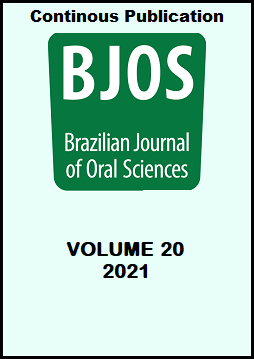Abstract
Aim: This study aimed to evaluate how meta-analyses are conducted and reported in dentistry. Methods: We conducted a search to identify dentistry-related Systematic Reviews (SRs) indexed in PubMed in 2017 (from January 01 until December 31) and published in the English language. We included only SRs reporting at least one meta-analysis. The study selection followed the 4-phase flow set forth in the Preferred Reporting Items for Systematic Reviews and Meta-Analyses Statement (PRISMA), and it was independently conducted by two researchers. Data extraction was performed by one of three reviewers, and data related to conducting and reporting of the meta-analysis were collected. Descriptive data analysis was performed summarizing frequencies for categorical items or median and interquartile range for continuous data. Results: We included 214 SRs with meta-analyses. Most of the studies reported in the title that a meta-analysis was conducted. We identified three critical flaws in the included studies: Ninety (90) meta-analyses (43.1%) did not specify the primary outcome; most of the meta-analyses reported that a measure of statistical heterogeneity was used to justify the use of a fixed-effect or random-effects meta-analysis model (n=114, 58.5%); and a great part did not assess publication bias (n=106, 49.5%). Conclusion: We identified deficiencies in the reporting and conduct of meta-analysis in dentistry, suggesting that there is room for improvement. Educational approaches are necessary to improve the quality of such analyses and to avoid biased and imprecise results.
References
Page MJ, Higgins JPT, Sterne JAC. Assessing risk of bias due to missing results in a synthesis. In: Higgins J, Thomas J. Cochrane handbook for systematic reviews of interventions. Cochrane; 2019. Version 6.0. Chapter 13.
McKenzie JE, Beller EM, Forbes AB. Introduction to systematic reviews and meta-analysis. Respirology. 2016 May;21(4):626-37. doi: 10.1111/resp.12783.
Ioannidis JP. The mass production of redundant, misleading, and conflicted systematic reviews and meta-analyses. Milbank Q. 2016 Sep;94(3):485-514. doi: 10.1111/1468-0009.12210.
Page MJ, Altman DG, McKenzie JE, Shamseer L, Ahmadzai N, Wolfe D, et al. Flaws in the application and interpretation of statistical analyses in systematic reviews of therapeutic interventions were common: a cross-sectional analysis. J Clin Epidemiol. 2018 Mar;95:7-18. doi: 10.1016/j.jclinepi.2017.11.022.
Saltaji H, Cummings GG, Armijo-Olivo S, Major MP, Amin M, Major PW, et al. A descriptive analysis of oral health systematic reviews published 1991-2012: cross sectional study. PLoS One. 2013 Sep;8(9):e74545. doi: 10.1371/journal.pone.0074545.
Jayaraman J, Nagendrababu V, Pulikkotil SJ, Innes NP. Critical appraisal of methodological quality of Systematic Reviews and Meta-analysis in Paediatric Dentistry journals. Int J Paediatr Dent. 2018 Nov;28(6):548-560. doi: 10.1111/ipd.12414.
Bassani R, Pereira GKR, Page MJ, Tricco AC, Moher D, Sarkis-Onofre R. Systematic reviews in dentistry: Current status, epidemiological and reporting characteristics. J Dent. 2019 Mar;82:71-84. doi: 10.1016/j.jdent.2019.01.014.
Moher D, Shamseer L, Clarke M, Ghersi D, Liberati A, Petticrew M, et al. Preferred reporting items for systematic review and meta-analysis protocols (PRISMA-P) 2015 statement. Syst Rev. 2015 Jan;4(1):1. doi: 10.1186/2046-4053-4-1.
Liberati A, Altman DG, Tetzlaff J, Mulrow C, Gøtzsche PC, Ioannidis JP, et al. The PRISMA statement for reporting systematic reviews and meta-analyses of studies that evaluate healthcare interventions: explanation and elaboration. BMJ. 2009 Jul;339:b2700. doi: 10.1136/bmj.b2700.
Page MJ, Shamseer L, Altman DG, Tetzlaff J, Sampson M, Tricco AC, et al. Epidemiology and reporting characteristics of systematic reviews of biomedical research: a cross-sectional study. PLoS Med. 2016 May;13(5):e1002028. doi: 10.1371/journal.pmed.1002028.
Kattan S, Lee SM, Kohli MR, Setzer FC, Karabucak B. methodological quality assessment of meta-analyses in endodontics. J Endod. 2018 Jan;44(1):22-31. doi: 10.1016/j.joen.2017.07.019.
El-Rabbany M, Li S, Bui S, Muir JM, Bhandari M, Azarpazhooh A. A Quality analysis of systematic reviews in dentistry, part 1: meta-analyses of randomized controlled trials. J Evid Based Dent Pract. 2017 Dec;17(4):389-98. doi: 10.1016/j.jebdp.2017.06.004.
Thornton A, Lee P. Publication bias in meta-analysis: its causes and consequences. J Clin Epidemiol. 2000 Feb;53(2):207-16. doi: 10.1016/s0895-4356(99)00161-4.
Koletsi D, Valla K, Fleming PS, Chaimani A, Pandis N. Assessment of publication bias required improvement in oral health systematic reviews. J Clin Epidemiol. 2016 Aug;76:118-24. doi: 10.1016/j.jclinepi.2016.02.019.
Tricco AC, Cogo E, Page MJ, Polisena J, Booth A, Dwan K, et al. A third of systematic reviews changed or did not specify the primary outcome: a PROSPERO register study. J Clin Epidemiol. 2016 Nov;79:46-54. doi: 10.1016/j.jclinepi.2016.03.025.

This work is licensed under a Creative Commons Attribution 4.0 International License.
Copyright (c) 2021 Brazilian Journal of Oral Sciences


